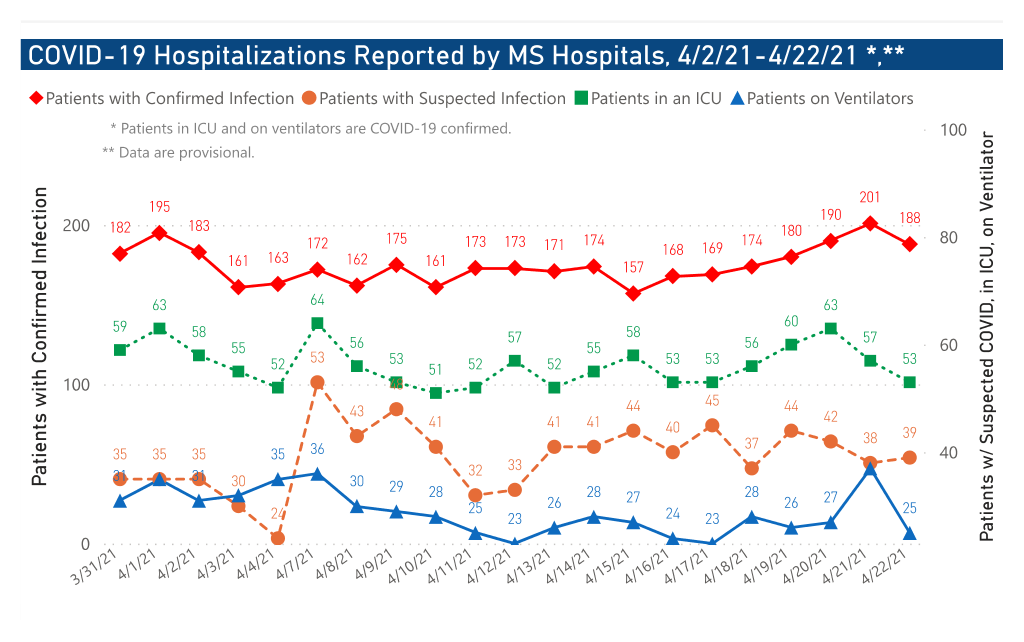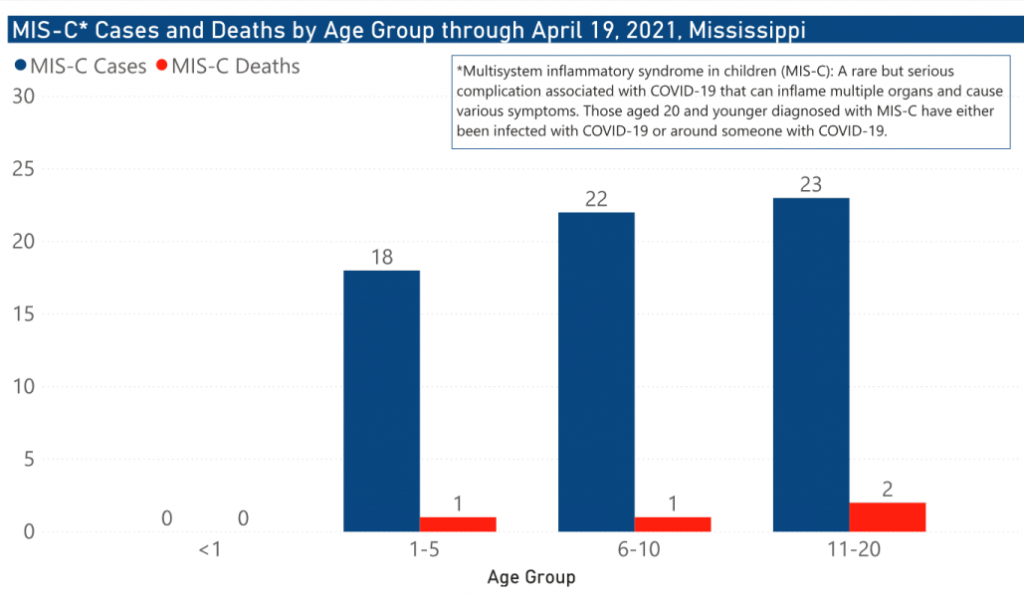Gov. Tate Reeves is rushing to declare victory in the fight against COVID-19 in Mississippi for the third time. His apparent determination to lift the last social restrictions on April 30 runs the real risk of a Final Wave in May and June, which will likely prolong the pandemic well into the summer. That last 10% would mean another 30,000 new infections and approximately 750 deaths. Such should not be considered “acceptable” or merely “manageable.”
I have closely followed the data provided by the Mississippi State Department of Health daily for over a year, and watched the number of COVID-19 cases and deaths go from one to 310,349 confirmed cases, and from one to 7,175 deaths as of April 22, 2021.
I can tell you just how tricky COVID-19 can be. It exploits any opportunity for transmission. Yet, once again Gov. Reeves offers the virus another opportunity to spike in Mississippi for the third time. If he thinks the pandemic is over, he is sorely mistaken. The 6,000 new cases and 175 recorded deaths in the past month, between March 26 and April 22, are not evidence of “victory.” They are evidence of a dangerous plateau, and we must pay attention, or we will pay the piper as before.
We must pay attention to the actual numbers MSDH has reported, which contradict the governor’s happy talk (again), which is concerning. Since late March, Mississippi has had: a high statewide test positivity rate of 8%-10% (twice the CDC safe rate of 5%); an emerging April trend of rising COVID-19 hospitalizations and ICU usage; a weakened health-care system that is stretched thin even in normal circumstances; a resurgence in long-term-care facility outbreaks, presumably among unvaccinated staff, including breakthrough infections among fully vaccinated residents (see Armed Forces Retirement Home, Gulfport); the exponential spread of the more-contagious B.1.1.7/UK variant (and now four other variants MSDH is tracking) throughout the state; the clear evidence of continuing community transmission among all reported population groups (by race, ethnicity, and age); and declining vaccination demand and a stalling in new vaccinations, leaving Mississippi as one of the least-vaccinated states, with some counties reporting just 13% of the population fully vaccinated. Weekly vaccinations peaked in late February/early March, and have steadily declined through the month of April.
A Dangerous Late-Game Plateau
Mississippi is in a dangerous late-game plateau, poised for a final wave, just as victory is in sight. After April 30, minor league and college baseball parks will be allowed full capacity, gathering thousands, and music concerts and public festivals of all kinds. Also, Memorial Day weekend gatherings are looming.
It may no longer be time to panic, but it most certainly is time to stay the course.

Mississippi’s governor needs a reality check. He is celebrating a winning touchdown when the ball is actually on the 15-yard line, while up by a field goal deep into the fourth quarter. All it takes is a fumble or an interception, folks. Or if you prefer a baseball analogy, given the season, consider this: We are in the top of the 8th inning, up by a couple of runs, and the visiting team has a man at 2nd, and 1 out. We need a bullpen call. We need the closer. But the coach thinks we’ve already won, ignoring the pitching coach.
Since Mandate Ended, 50 Young Adults Hospitalized and Nine Died
Recently, I stopped in at a local BBQ joint in midtown Hattiesburg for a to-go order. The place was packed. While inside to order, I was the only customer wearing a protective mask, even though I am fully vaccinated. I waited outside for a half-hour for my order, and inside all tables were full with a line to get in. Most people inside spent at least an hour or longer breathing each other’s air. One can only wonder about the ventilation system in that 100-year old house, now converted to a restaurant.
Many were also families with children, who by definition were not vaccinated and, again, not a mask in use (except for the servers, mostly). And this was in Hattiesburg with its city-wide mask and other mandates still in effect. I can only imagine what it must be like in counties and localities where people can do whatever they want as if this pandemic didn’t exist, as if they can party like it’s 2019.
Since Gov. Reeves effectively declared victory, ending his statewide masking and most other mandates on March 2, and the rest “very, very soon,” the state has reported 15,054 new confirmed infections as of April 22—a cumulative increase of 5%, and 437 new COVID-associated deaths (a 7% increase). The crude mortality rate increased 27%, from a cumulative rate of 2.28% as of March 1, to 2.90% since.
Since March 1, some 435 people have been hospitalized with severe symptoms. Though the vast majority were over age 50, and especially over 65, let us remember that these age groups have the highest vaccination rates in the state, and yet hundreds have been hospitalized with the virus. Just as ever, seniors (65+) remain the most vulnerable, representing 71% of people sick enough to require hospitalization and 72% of recent recorded deaths.
Simultaneously, at the other end of the age spectrum, between March 1 and April 19, children with COVID-induced MIS-C, a rare but dangerous pediatric inflammatory syndrome with unknown long-term effects, increased by 43%. These included +10 among pre-teens/teens (11-20) of whom one died (aged 11-17); +4 among tender-age children (6-10), and +5 among toddlers (1-5) for goodness sake. And these are just the confirmed cases. Since March 1, Mississippians of every age, from 0-4-year olds to 65+, have been so sick from the virus as to be admitted to hospital.
Since ending the mask mandate, nearly 50 young adults (18-39) were hospitalized and 9 died. For people in their 40s, 46 had to be hospitalized and 19 died. For those over age 65, again the most vaccinated class, their crude mortality rate (+1897 cases, +322 deaths) is an astounding 16.97%.
Are these tragic facts acceptable? Are they evidence of “victory” in the fight against COVID?

Hospitals: A Concerning Lack of Available Capacity
April 21 was the sixth day in a row of increasing daily hospitalizations, after a month of a slow but steady decline, followed by a plateau. The state’s biggest hospitals are now reporting a concerning lack of available capacity. If this new trend of rising medical system metrics continues in concert with rising numbers of new infections amid stagnating vaccination rates and the alarming spread of new COVID-19 variants—well, we could be in trouble. This is particularly true for the 77% of Mississippians who are not yet fully vaccinated.
On April 22, the state’s only Level I trauma center, UMMC in Jackson, was absolutely full, MSDH reported. Every single staffed bed (all 382) and every single adult ICU bed (87) were in current use, and the hospital had to arrange transfer of 33 severely ill new patients (-33 bed capacity) as well as nine requiring life-saving mechanical ventilators (-9 capacity). And this with only 20 current COVID patients and six on ventilators. Right now, UMMC has zero capacity for any additional patients, COVID-related or otherwise.
On the same day, metro Jackson’s major Level II trauma hospital, Mississippi Baptist, reported zero of its 382 staffed beds were available, and only five of its 38 adult ICU beds. With only 13 current COVID patients and three on ventilators, Baptist was all but full. In north Mississippi, Baptist DeSoto, a Level II, had not a single staffed bed (of 192) nor an ICU bed (of 36) available, and with 26 COVID patients and seven in ICU. Delta Regional, another Level II, had just 15 (of 120) available beds and zero (of 16) ICU beds available.
Meanwhile, since the first week of April the medical services numbers have reversed from a decline to a fluctuating plateau statewide and continues to increase as weekly numbers of new cases rise. LTC outbreaks are also increasing, doubling from 15 on April 8 to 27 by April 22. Since March 26, there has been consecutive weekly increases in new infections among the two largest population groups—non-Hispanic Black and white Mississippians.
In the week ending April 1, there were +393 new confirmed cases among NH Black people, compared to +524 in the week ending April 22. Over this interval some 1,822 NH Black Mississippians tested positive for COVID. New confirmed infections among NH whites steadily increased from +546 to +758, or +2,670 in four weeks. Furthermore, for both groups the rate of increase also increased, not just the nominal numbers. This secular trend in the time of widely available vaccination is an obvious red flag.
Red Flag: The Growth of Variants
An even more obvious red flag is the exponential growth and spread of documented COVID-19 variants in the state, all since mid-March.
MSDH is now tracking five variants of concern, and the latest report shows that all five are present: B.1.1.7 (UK), B.1.351 (South Africa), B.1.427 (California/a.), B.1.429 (California/b.), and P.1 (Brazil/Japan). The most widely evident one is the B.1.1.7 variant, first detected in the UK. As of March 19, two of the then-three tracked variants were in the state, a total of 11 cases in 8 counties; 10 cases were the UK variant and one was the B.1.351 variant first detected in South Africa. By March 26, the number of variant cases, now including four strains, tripled to 34 cases in 17 counties, of which 75% were the UK strain. Two weeks later, the numbers of documented variants increased five-fold to 174 in 39 counties (about half of the state).

As of April 23, another 149 new cases were reported, with the cumulative total doubling to 323, with all five tracked variants evident in the state. Right now fully 70% of the state’s counties (57 of 82) have documented COVID-19 variants in their respective populations, and in all corners of the state. Clearly we are now seeing community transmission of variant strains.
In the northern counties, DeSoto jumped from two (March 19) to 7 (March 26) to 15 (April 9) to 47 (April 23), nearly all UK strain. Marshall County went from zero in March to 9 (April 9) to 19 (April 23). Yalobusha County reported one on March 26, seven by April 9, and 12 by April 23.
The metro Jackson counties (Hinds, Madison, Rankin) went from one in Hinds on March 19, to two on March 26, to 56 by April 9, to 82 by April 23.
The four coastal counties (Hancock, Harrison, Jackson, Pearl River) have gone from three on March 19, to five by March 26, to 16 by April 9, to 27 by April 23.
Anyone who dismisses this trend of variant spread as “just a few” cases, especially in this spring of vaccination (but also of increased travel and of lifting of restrictions), is asking for trouble.
As we approach the end of April and the governor’s ending of any statewide anti-COVID measures, many lights are again beginning to blink red. Nota bene.
We must heed the latest warning of April 22 by Dr. Dobbs, who for a full year now has been Mississippi’s Dr. Fauci: “Trending up last week. The future is in our hands. Fight COVID, get vaccinated.”
And we must remind Gov. Reeves that this thing ain’t over until it’s over, no matter what he might wish.
CORRECTION: The original essay about contained a typo about the number of patients on ventilators at UMMC in Jackson on April 22. It was six patients, not 65. We apologize for the error.
This MFP Voices essay does not necessarily represent the views of the Mississippi Free Press, its staff or board members. To submit an essay for the MFP Voices section, send up to 1,200 words and factcheck information to azia@mississippifreepress.com. We welcome a wide variety of viewpoints.






